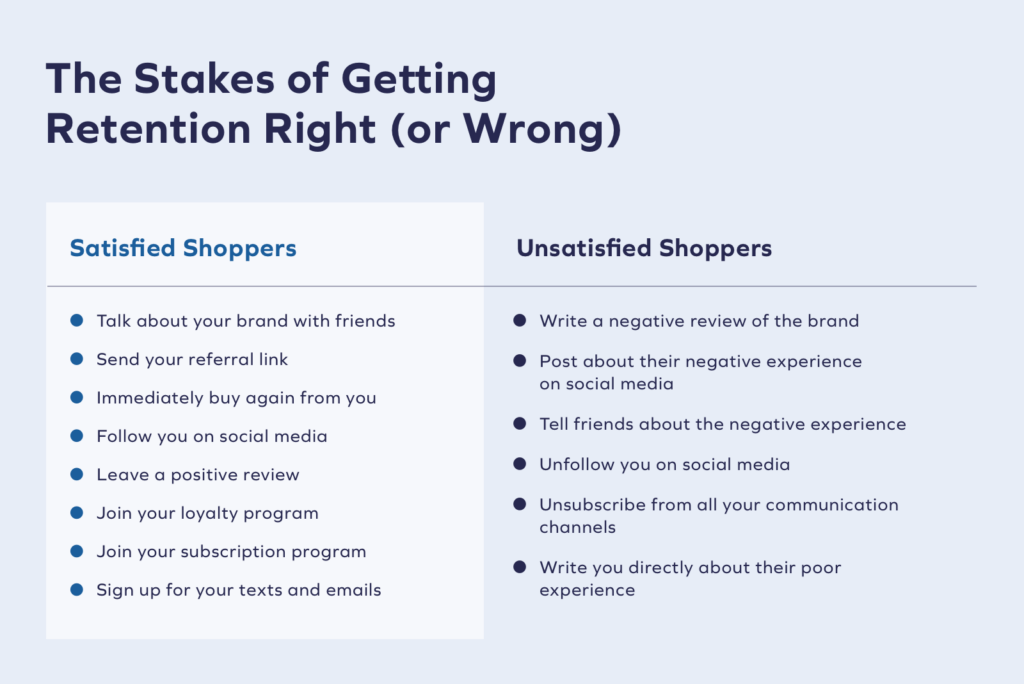Once defined almost wholly by new customers, eCommerce brands are looking beyond the first-time sale to succeed. Businesses of the next decade are instead measuring their success by customer loyalty: Will shoppers be with your brand in a month? Two months? Next year?
Now more than ever, brands need to nail customer retention. In our State of Retention Survey, we found over 50% of brands are more focused on retention efforts than ever before, and yet, 40% haven’t changed their strategy to achieve their goals.

Why are brands still missing the mark despite knowing they need to keep customers coming back? Retention is much more multidimensional than acquisition; retention demands you treat first-time, two-time, repeat, and loyal shoppers with nuance. And, the margin of error is that much smaller.
As we move into 2023, it’s becoming obvious that brands aren’t creating the post-purchase experiences that today’s consumers are seeking out. Of the brands surveyed, 70% said their retention rate has remained stagnant or gotten worse over the past year.

With acquisition costs at an all-time high, brands won’t survive if they continue to neglect customers’ distinct needs and behaviors. “You can’t create a transactional brand anymore — you can’t be only about the first purchase. Retention has to be top of mind,” says James Reu, eCommerce Manager at LSKD.
Despite good intentions and best efforts, brands are creating disparate, disjointed customer experiences.
The problem at hand
These half-baked customer experiences aren’t due to just one thing, either. Brands are stifled by their current capabilities, meaning gaps in the customer journey are somewhat inevitable. Brands are also limited by their data on shoppers, which will only be exacerbated by the slow, despairing death of the third-party cookie. And to make matters worse, the customer data brands do have often live in siloes, inconveniencing, well, everyone.
If you can’t see the full picture of a customer’s journey, how can you influence it? These disjointed, frustrating customer experiences are a headache for brands, too. With every step separated from one another, brands can’t:
- Get a high-level, holistic view of their customers
- Understand which efforts drive the needle
- Discern what keeps customers returning for more
But what real strategies do brands have to fix this? Additional, costly solutions that, at best, create an unsatisfactory patchwork? Engagement strategies backed by scant data? Brands don’t even have accurate, holistic retention benchmarks to measure their efforts. Based on our data, 72% of brands solely focus on repeat purchase rate as a measure of success, which just isn’t going to cut it in today’s market.
Customers are teed off and turning over
These limitations are causing you critical blindspots. Brands can’t recognize their shoppers at every touchpoint, making the customer journey disparate and disconnected. Not only that, but brands can’t provide shoppers value at these touchpoints either. Customer loyalty today hinges on this value exchange: 1 in 3 shoppers will stop doing business with a brand they love after a single bad experience.
What do these blindspots look like to customers?
- Naomi leaves a negative review as a new shopper. Rather than reaching out to smooth things over with Naomi, the brand immediately sends Naomi an email about their upcoming promotional sale. The brand’s limited understanding of Naomi’s customer profile costs them. Naomi churns.
- Chrissy earned 500 loyalty points with her last purchase, but she wasn’t told about her point balance…or her point expiration date. The brand isn’t notifying their shoppers of critical updates on their account status, like point expiration and VIP tier changes. In turn, shoppers like Chrissy can’t reap the rewards of loyalty membership. Chrissy churns, and the brand loses a high-value shopper.
- Marshall gets constant promotional emails about a product he’s already subscribed to on a monthly basis. No one likes spam messages, especially when they’re about a product you’re actively buying. The brand isn’t seeing their customers holistically and can’t engage them properly. Marshall unsubscribes from the brand’s emails and stops his subscription altogether. Marshall, too, churns.
But these disconnects are causing more than just customer churn. Unhappy customers will:
- Write a negative review of the brand
- Post about their negative experience on social media
- Tell friends about the negative experience with the brand
- Unfollow the brand on social media
- Unsubscribe from the brand’s communications e.g. email, SMS
- Write the brand directly about their poor experience
Getting the post-purchase experience wrong doesn’t just mean losing out on a sale. It causes reverberations. Shoppers disengage entirely, and they bring others with them.

Perfecting the post-purchase experience
But don’t despair; these disconnects have solutions. Perfecting the post-purchase experience starts with creating shared customer data, building cohesion among your retention strategies, and offering experiences that truly speak to one another.
“Connected data is like a secret weapon for customer retention. It’s all about linking different pieces of customer data – purchase history, interactions, preferences, and feedback – to get a full picture of your customers. Armed with this knowledge, you can take your strategy to the next level by delivering ultra-personalized experiences, crafting tailored marketing campaigns, and implementing spot-on recommendations. The result? A seamless and satisfying customer experience that keeps them coming back for more, boosting your customer retention rates year after year.”
– Stephanie Liu, Founder, Levitate Foundry
Connecting your data creates a 360-degree view of your shoppers. You’ll better understand their product preferences, purchase history, sentiments toward the brand, and even their engagement channel of choice. With shared data, you don’t have to guess about your shoppers; you already know.
With this data at the ready, you can personalize at scale with segmentation, which 71% of consumers expect from brands. Create high-impact segments, understand specific audiences, and effectively target shoppers to catalyze desirable behavioral change. You can engage one-time shoppers with retention-focused campaigns and get them to come back. Or, key into customers at risk of churning or those ready to make a purchase at the right time with the right message.
And what can brands gain when they get these interactions right? Over 70% of shoppers say good experiences factor into their purchase experience, just behind price and product quality. And 65% of U.S. consumers say a positive experience with a brand is more influential than great advertising. Not to mention, happy customers will:
- Talk about your brand with friends
- Send your referral link to friends and family
- Immediately buy again from you
- Follow you on social media
- Leave a positive review
- Join your loyalty program, extending CLTV
- Join your subscription program, boosting AOV
- Sign up for your texts and emails
Are you ready to fix your customer journey? Let’s chat.














 Join a free demo, personalized to fit your needs
Join a free demo, personalized to fit your needs